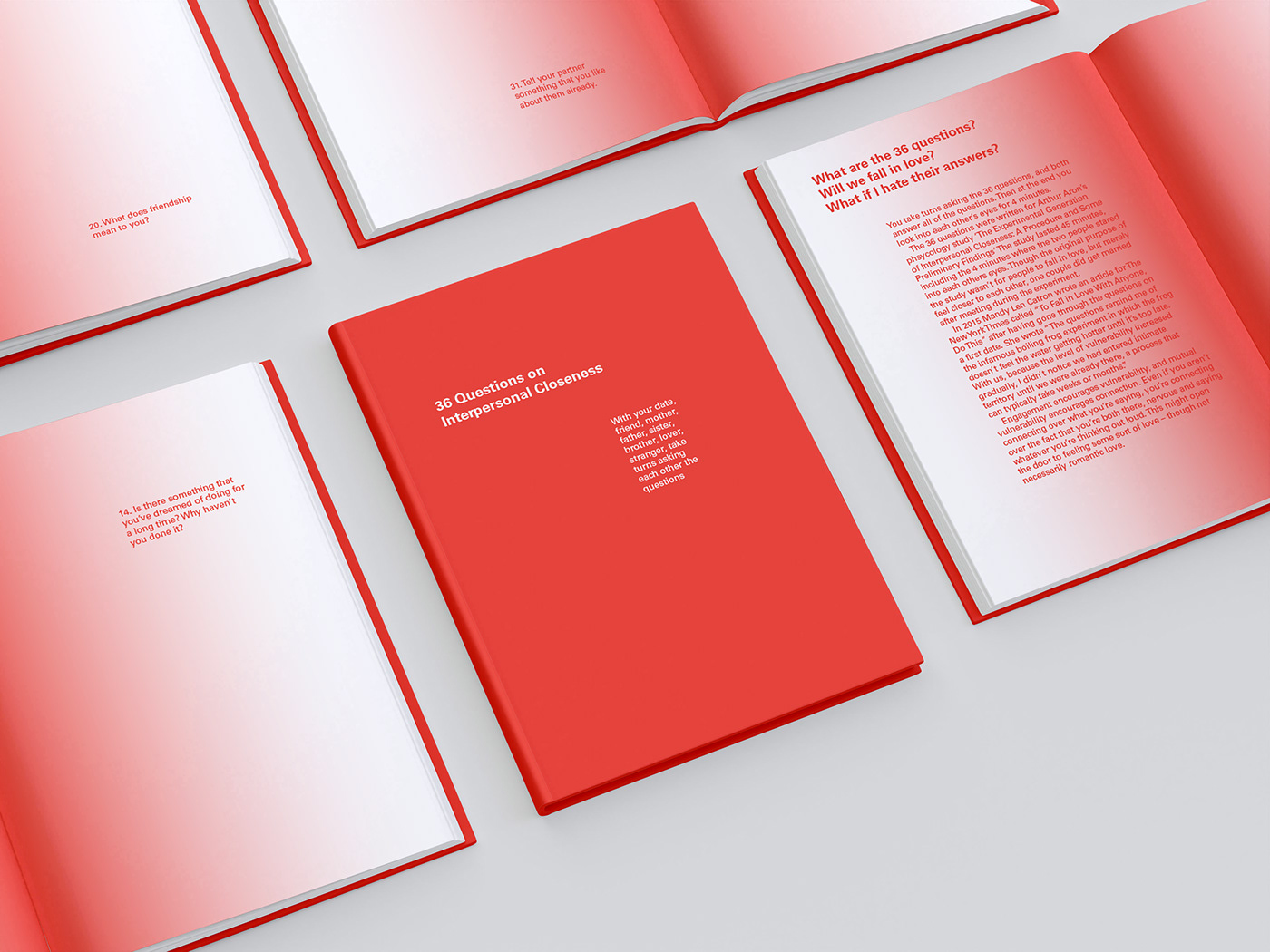Aim
The aim of this project is to create a real world experience that increases intimacy and familiarity between two people, through the 36 questions included in the study The Experimental Generation of Interpersonal Closeness by the psychologist Arthur Aron, in order to challenge, confront, and question modern online dating. It can at times can be quick and superficial, where going through these questions is a longer process of getting to know someone.
The Experimental Generation of Interpersonal Closeness: A Procedure and Some Preliminary Findings
The original study sat two people in front of each in a lab, and asked them to go through the 36 questions in order. It lasted roughly 45 minutes, including the 4 minutes’ section where the two people stare into each other’s eyes. Though the original purpose of the study wasn't for people to fall in love, but merely feel closer to each other, one couple did get married after meeting during the experiment.
In 2015 Mandy Len Catron wrote an article for The New York Times called "To Fall in Love With Anyone, Do This" after having gone through the questions on a first date. She wrote "The questions remind me of the infamous boiling frog experiment in which the frog doesn't feel the water getting hotter until it's too late. With us, because the level of vulnerability increased gradually, I didn't notice we had entered intimate territory until we were already there, a process that can typically take weeks or months."
Elaine Aron, co-writer of the questionnaire, said that "the basis of the 36 questions is that back-and-forth self-disclosure, that increases gradually (not too fast), is consistently linked with coming to like the other person you do this with. We just made it a systematic method that could be used in the lab."

"As humans we are constantly looking for love and acceptance; we want to remind ourselves that we exist so as to get out of our minds. Being in touch with our physical selves allows for that connection to others."
Erin Riley


Clothing
Even though the study is over 20 years old, it hasn't really been brought out of the lab. Articles have been written about the questions, and if you want to go through the questions yourself you can print out a simple list, but nothing further has been done with them. By having the questions displayed on clothing, it places them out in the real world and sets the questions free.
The questions allow for an experience between two people that increases intimacy and familiarity. It challenges modern online dating, which can be very quick and superficial, and often you don't even see the person in real life. The questions encourage openness and conversation between people in real life, and provide a way of making a deeper connection with someone.
Clothing is already a language in itself, so the embroidered questions add extra meaning to the different articles of clothing. It allows you to ask the questions without speaking, the clothing does the (initial) talking. The questions are grouped in three sets, with each gradually increasing in level of vulnerability. The questions are placed on clothing from outerwear to underwear, physically mirroring this increase in intimacy.
The questions are kept fairly small and placed in more hidden placements, increasing the idea of intimacy as you have to be closer to the person to read them. It keeps the questions in a space between private and public by having personal questions in intimate placements, but still visible on the clothing worn out in public.
The questions are embroidered onto the clothing, as embroidery is a slower process, relating to the slow process of getting to know each other through the questions. It is also has a more personal feel to it, referencing the personal nature of the questions.

"Cloth is the body’s first architecture; it protects, conceals and reveals."
Ann Hamilton





Tablecloth
I included a tablecloth as its function is to dress a table like you dress yourself, so it mirrors the effect of the clothing. The tablecloth is also something you would expect to find on a dinner date, and could provide useful questions for a nervous couple on their first date.
The gingham pattern, usually found on tablecloths, is used as a grid to place the text. I then removed the gingham, leaving the questions in focus. All the even numbered questions are facing one way, and all the odd numbers the opposite way. This allows for the couple to take turns asking each other the questions. Most of the questions stay on separate halves of the tablecloth, but a few reach over the centre line, drawing the people closer together as they talk.

“Where the myth fails, human love begins. Then we love a human being, not our dream, but a human being with flaws.”
Anaïs Nin





